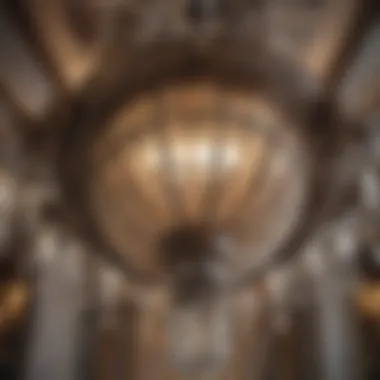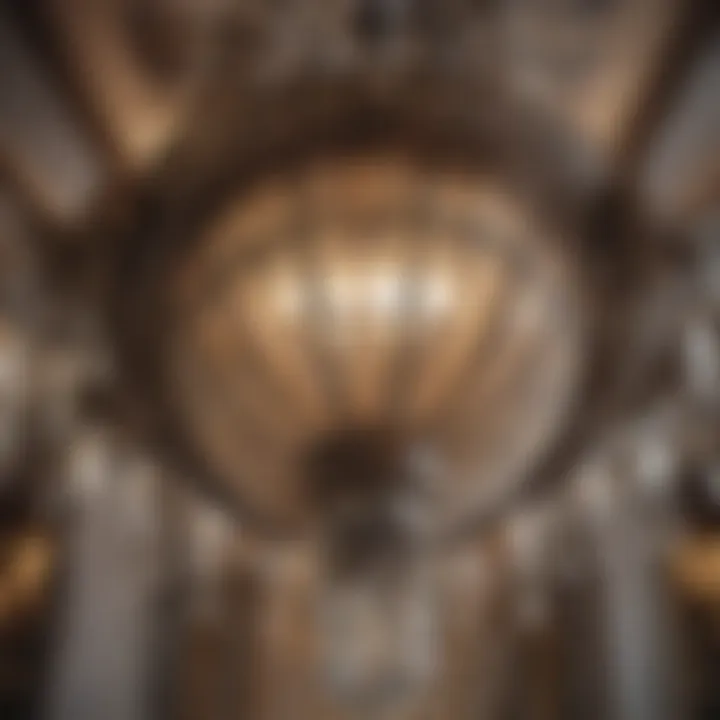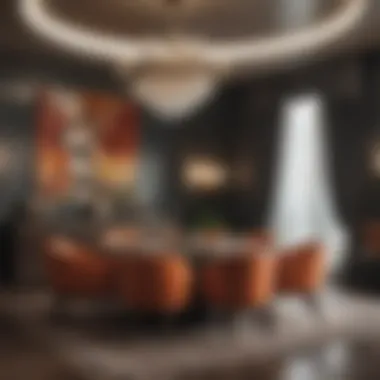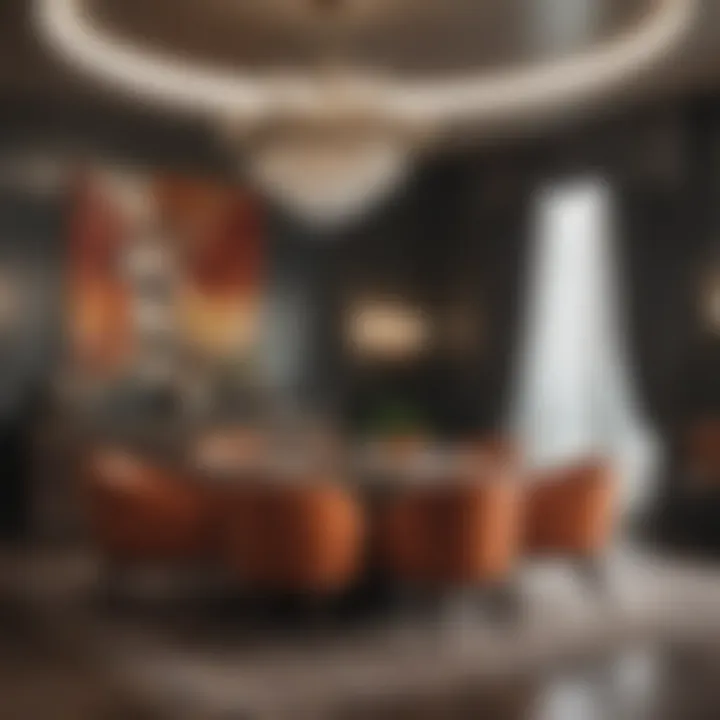Exploring the Intricacies of Art Deco Decor


Intro
The art of decor has long been a reflection of cultural evolutions and societal norms. Among the many styles, Art Deco stands out for its bold embrace of modernity and opulence. Born in the 1920s, this design movement thrived during a time when innovation and creativity flourished. This article aims to explore the various facets of Art Deco decor, establishing a clear connection between its historical roots and current applications.
Art Deco is characterized by an array of geometric shapes, vibrant colors, and luxurious materials. The movement has not only influenced interior design but also architecture, fashion, and visual arts. As we delve into the specifics, we will highlight essential elements that make Art Deco distinct, offering insights into how contemporary designers can incorporate its essence into present-day spaces. Understanding this history and aesthetic is invaluable for anyone keen on elevating their environments with a touch of the grand past coupled with modern designs.
Exquisite Architectural Designs
Art Deco architecture is notable for its visual dynamism and unique structural features. It melds various influences—from the classical styles of ancient Greece and Rome to the streamlined forms of the emerging industrial age.
Unique Home Features
Art Deco homes often showcase elements such as:
- Symmetry and Balance: Clean geometric lines create a pleasing aesthetic.
- Materials: Use of glass, chrome, and exotic woods adds a luxurious feel.
- Ornamental Detailing: Features like bold reliefs or intricate moldings proclaim an air of sophistication.
These characteristics help in crafting homes that are not merely places of living but also showcases of artistry.
Historical Significance
The roots of Art Deco can be traced to the 1925 Exposition Internationale des Arts Décoratifs et Industriels Modernes in Paris. This landmark event celebrated the interplay of decorative arts and industrial design. The movement swiftly gained traction, influencing structures such as the Chrysler Building and Empire State Building in New York.
The significance lies in its representation of a broader cultural shift towards modernism. As societies moved past the ornate styles of the previous century, Art Deco emerged as a beacon of the new, shaping skylines and interiors that still resonate with audiences today.
Interior Decorating Tips
For those who wish to embody the spirit of Art Deco within their interiors, certain guiding principles can aid in achieving that atmosphere.
Color Schemes and Trends
Art Deco favors a bold yet sophisticated palette. Popular choices include:
- Deep Rich Tones: Such as emerald greens, sapphire blues, and ruby reds.
- Metallic Accents: Gold and silver often enhance nearly any color scheme, adding glamour and shine.
Combinations can also merge neutral backdrops with these striking hues to invoke a sense of balance and modernity.
Space Optimization Techniques
Implementing Art Deco does not necessitate vast spaces. Small areas can be maximized with smart design strategies, including:
- Mirror Use: Strategically placed mirrors create the illusion of depth and reflect light.
- Multipurpose Furniture: Furnishings that serve multiple purposes help reduce clutter while maintaining style.
For anyone eager to transform their surroundings, applying these techniques can marry functionality and aesthetic beautifully.
Art Deco remains a testament to a period where luxury met utility, infinitely inspiring generations of designers and homeowners.
The journey through Art Deco decor opens a gateway to understanding how historical contexts can influence and elevate contemporary design. Enthusiasts and professionals alike can draw from this rich history to foster environments that honor both the past and the modern era.
Historical Context of Art Deco
Understanding the historical context of Art Deco is essential for appreciating its significance in the world of design. This period marks a transition away from the ornate styles of the past and introduces a new era defined by modernity and functionality. Art Deco emerged during a time of great change, influenced by the technological advancements and cultural shifts of the early 20th century. The 1920s and 1930s were periods of prosperity and innovation, which played a crucial role in shaping the aesthetic language of this movement.
Origins and Influences
Art Deco originated from a mixture of styles and influences. It drew inspiration from diverse sources such as Cubism, Futurism, and even traditional craftsmanship. The 1925 Exposition Internationale des Arts Décoratifs et Industriels Modernes in Paris is often cited as the birthplace of the movement, showcasing the blend of art and industry that would define Art Deco. Those years also saw a rise in travel and global cultures. Hence, elements from various cultures influenced the decorative arts. For instance, the clean lines and geometric forms were a nod to modernist principles while the elegant materials reflected luxury.
The use of bold colors and intricate details can also be traced to earlier design movements. Artists began exploring new materials like chrome and Bakelite, which were prevalent in the design of everything from buildings to everyday items.
Art Deco in the 1920s and 1930s
The 1920s and 1930s were pivotal decades for Art Deco. The aftermath of World War I led to a societal shift, as people sought to escape the severity of the previous years. This is reflected in Art Deco’s vibrant colors and whimsical designs.
During these decades, decor became a symbol of affluence and modern living. The style found its way into various aspects of life, including architecture, fashion, and automobiles. Iconic structures like the Chrysler Building and streamlined vehicles are testaments to this integration.
Art Deco's dominance in the 1930s can be understood through its adoption in upscale hotels, theaters, and commercial buildings. It became synonymous with luxury and sophistication, yet it was also fascinatingly functional. The emphasis on geometric patterns delivered an aesthetic experience while maintaining usability and comfort.
The appeal of Art Deco during this time stemmed from its ability to balance elegance with modernism, allowing the era to celebrate both progress and nostalgia. Factors such as the economic recovery in the 1930s further facilitated the proliferation of the style in public and private spaces, marking this as a golden age of design.
Defining Characteristics
Art Deco stands as a pivotal design movement, particularly in its historical and aesthetic contributions to decor. Defining characteristics of this style encompass a range of elements that come together harmoniously, crafting a unique visual language. Understanding these traits is key to appreciating Art Deco's enduring appeal and its integration into modern designs.
Geometric Shapes and Patterns
Geometric shapes and patterns are the cornerstone of Art Deco decor. Unlike the organic forms of prior styles, Art Deco celebrates sharp angles and streamlined silhouettes. This emphasis on geometry creates a sense of order and elegance. Common motifs include chevrons, zigzags, and stylized florals, all rendered in a bold manner.


The use of repeating patterns is essential, as they contribute to the rhythmic quality seen in interiors and architecture. Designers often deploy these patterns in wallpapers, textiles, and floor designs, allowing spaces to express the distinctive Art Deco vibe. Patterns in Art Deco can evoke movement and energy, which aligns perfectly with the post-war optimism of the 1920s and 30s.
Use of Luxurious Materials
Material choice is also significant in defining Art Deco. This style embraces a mix of opulence and modernity. Common materials include polished metals, glass, and rare woods. Chrome and stainless steel provide a sleek, contemporary feel. On the other hand, luxurious fabrics like silk and velvet add softness and warmth.
The integration of glass, especially cut or etched glass, has been a hallmark of the genre, enhancing the light and spatial perception of a room. Additionally, the use of exotic woods or finishes for furniture elevates the aesthetics. Overall, the careful selection of materials not only showcases craftsmanship but also reflects the wealth and aspirations of the era.
Color Palettes and Textures
Art Deco is not merely about shapes and materials; color palettes and textures play crucial roles as well. Colors often lean towards rich jewel tones like emerald greens, deep blues, and bold reds, balanced by neutrals such as black and white. This application of vibrant colors can create dramatic contrast, enhancing the visual impact of a room.
Textures in Art Deco decor are equally diverse. Smooth, polished surfaces are frequently juxtaposed with textured finishes, providing depth and sensory interest. Textures can be seen in decorative elements like friezes, fabrics, and finishes, which enliven spaces. The interplay between color and texture ultimately contributes to the layered richness characteristic of this style.
"Art Deco represents the perfect marriage of craftsmanship and modern aesthetics, making it timeless and relevant even in contemporary settings."
The understanding of these defining characteristics of Art Deco decor is essential for anyone wishing to incorporate this distinctive style into their spaces. By leveraging geometric forms, luxurious materials, and striking color palettes, one can create environments that celebrate both history and innovation.
Key Elements of Art Deco Decor
Art Deco decor stands out not only for its visual flair but also for its rich array of design elements that form a cohesive and captivating aesthetic. Recognizing these key elements is essential for anyone looking to understand or integrate this style into their spaces. The importance of these aspects lies not only in their individual significance but also in how they work together to create a harmonious atmosphere. Each component contributes depth and character to Art Deco interiors, emphasizing luxury and elegance.
Furniture and Upholstery
Furniture and upholstery in Art Deco showcase bold lines and engaging shapes. Often, these pieces feature materials such as wood, metal, and leather, carefully styled to reflect the era's luxury. The furniture typically has a geometric quality; pieces might have curves, angles, and inlays that draw attention. For instance, a sofa may feature symmetrical lines complemented by rich fabrics that suggest sophistication.
One might consider the following when selecting Art Deco furniture:
- Material selection: Opt for polished wood or shiny metals that glide towards the luxury theme.
- Shape and form: Choose pieces that highlight geometric patterns and clean edges.
- Colors: Dark and rich hues often dominate, so consider deep blues, emeralds, and burgundies.
Beyond aesthetics, the comfort of furniture should not be overlooked. Art Deco seating often blends style with substance, allowing for inviting spaces that still maintain a refined ambiance.
Lighting Fixtures
Lighting in the Art Deco era serves both practical and decorative functions. Fixtures often display intricate designs, employing materials such as chrome, glass, and crystal. The nature of the metallic finishes and the detailed glasswork reflect the opulence of the time while ensuring that light diffuses in soft yet impactful ways.
When choosing lighting fixtures, consider these guidelines:
- Design: Look for fixtures with geometric patterns or stylized motifs.
- Size and scale: Ensure that pieces align proportionately with the room's dimensions.
- Color and finish: Metals and glass should complement the overall color scheme while providing warmth.
These elements allow for a gentle interplay between light and shadow, creating an atmosphere that is both dramatic and inviting. Lighting can serve as a focal point, making it crucial to select pieces that truly embody the Art Deco spirit.
Art and Sculpture
Art and sculpture function as vital components of Art Deco decor. They not only adorn spaces but also deepen the thematic essence of the design. Art Deco works often contain motifs derived from nature, mythology, and technology, showcasing the broader cultural influences of the time.
Art can manifest in varying forms:
- Sculptures: Choose pieces that feature dynamic lines and abstract forms to reflect the movement and innovation of the period.
- Paintings: Select artworks featuring bold colors and stylized figures.
- Wall decor: Consider decorative panels or murals that encompass the lavishness of Art Deco.
Incorporating art into the design should be a thoughtful process. Art pieces anchor a room's theme, guiding the aesthetic journey while echoing the historical context of the Art Deco movement.
"Art Deco represents a vibrant approach to design, elevating everyday items into creative expressions of sophistication."
Understanding these key elements allows for a more profound appreciation and application of Art Deco decor. Whether one seeks to create a singular statement or a seamless integration of the style into their home, the thoughtful implementation of furniture, lighting, and art can effectively convey the unique allure of Art Deco.
Prominent Art Deco Designers
The designers of the Art Deco movement played a crucial role in shaping its identity. Their work was not only about aesthetics but also reflected a broader social and cultural context during the early 20th century. Understanding these designers helps appreciate the depth and breadth of Art Deco decor. Notable figures such as Gio Ponti, Émile-Jacques Ruhlmann, and René Lalique contributed unique perspectives and innovations. Their designs emphasized luxurious materials, sophisticated shapes, and a blend of functionality with creative expression. An analysis of these designers highlights the intricate balance between artistry and craftsmanship, key to the enduring appeal of Art Deco.
Gio Ponti and his Contributions
Gio Ponti was an Italian architect, industrial designer, and furniture designer, well-regarded for his versatile contributions to Art Deco. His work displayed an elegant mix of modernism and decorative elements characteristic of the period. Ponti’s furniture designs, such as the exquisite Superleggera chair, showcased a lightweight, minimalist approach while maintaining a distinct visual flair. His famous designs for the Piazza della Libertà in Milan reflect the structural ingenuity of Art Deco. His emphasis on craftsmanship and high-quality materials made his pieces timeless.
For Ponti, art was not merely for aesthetic enjoyment but served practical function too. This sensibility can be seen in his interior designs, where every object contributes to an overall cohesive experience.
Émile-Jacques Ruhlmann's Influence
Émile-Jacques Ruhlmann was a French interior designer known for his luxurious and refined approach to furniture design. His work epitomized the elegance and sophistication associated with Art Deco. Ruhlmann's emphasis on rare woods, intricate marquetry, and sleek lines made his pieces highly sought after. His designs often incorporated themes of nature, showcasing stylized forms and organic shapes which gained popularity in the 1920s and 1930s.
One of Ruhlmann's most distinguished projects includes the interior of the 1925 Exposition Internationale des Arts Décoratifs et Industriels Modernes in Paris. His work there established a benchmark for quality and taste in Art Deco design.
Ruhlmann's influence can still be felt today, with many contemporary designers referencing his work in modern furniture design. He showed that functionality and beauty can coexist in harmony.
The Legacy of René Lalique


René Lalique holds a prominent place in the Art Deco movement, particularly in glass design and jewelry. His artistic vision revolutionized how glass was used in decor. Lalique's work combines intricate craftsmanship with an understanding of form and light. His designs often included nature motifs, drawing inspiration from flora and fauna, while employing innovative techniques to manipulate glass.
Notably, Lalique’s pieces, like the Masque de Femmes vase, highlight his mastery over glasswork, with forms that appear both robust and delicate. His designs were not limited to decorative arts; they extended into architecture through stunning glass panels and lighting fixtures.
Today, Lalique's legacy is harnessed in both contemporary design and luxury markets. His work continues to captivate collectors and fans of Art Deco decor, ensuring that his contributions remain relevant and revered.
Notable Art Deco Architecture
Art Deco architecture stands as a testament to creativity and elegance in the realm of building design. This style, rich in symbolism and diverse in expression, represents a significant aesthetic movement from the early 20th century. The importance of Notable Art Deco Architecture in today’s context lies in its ability to merge functionality with ornate beauty. Without understanding this architecture, one may overlook the sophistication that defines various structures across the globe. It is these buildings that often evoke inspiration in both design and cultural heritage.
Art Deco architecture emphasizes geometric shapes, vibrant colors, and intricate details. It often incorporates both modern materials and traditional craftsmanship, reflecting a time of innovation and stylishness. The notable buildings from this era often serve as cultural landmarks, representing the economic optimism and social progress of their time. Additionally, they provide insight into the architectural language that sought to break away from historical conventions, paving the way for Modernism.
The Chrysler Building
The Chrysler Building in New York City is perhaps one of the most famous examples of Art Deco architecture. Completed in 1930, it showcases the quintessential features of this style, including its distinctive spire and the use of stainless steel. The building, designed by William Van Alen, stands at 1,046 feet tall, making it an iconic part of the New York skyline. Its detailed ornamentation includes motifs like automobile hood ornaments, which speak to the industrial progress of the era.
This building's importance goes beyond its aesthetic value. It played a key role in establishing New York as a hub of architectural innovation during the early 20th century. The elegance of its design combined with modern engineering techniques made it a symbol of the American spirit and ambition. To this day, the Chrysler Building is celebrated for its aesthetic brilliance and remains a must-see for architecture enthusiasts.
The Miami Beach Art Deco Historic District
Another significant example of Art Deco architecture is the Miami Beach Art Deco Historic District in Florida. This neighborhood features over 800 preserved buildings from the 1920s and 1930s, showcasing a variety of Art Deco styles. The district has a unique charm, characterized by pastel colors, neon signs, and streamlined forms that reflect the gaiety and optimism of the era.
The preservation of this district highlights the importance of maintaining Art Deco heritage in urban settings. It enables modern society to appreciate the artistry involved in these structures. Tourists and locals alike flock to Miami Beach to immerse themselves in the Art Deco ambience while enjoying the area's vibrant culture. The historic district not only serves as a living museum of architecture but also fosters tourism and economic activity, illustrating the practical benefits of preserving such styles.
In summary, notable Art Deco architecture plays a crucial role in understanding the cultural and historical landscapes of cities like New York and Miami Beach. These structures encapsulate artistry and ingenuity, influencing contemporary designs and informing our approach to urban preservation.
Integrating Art Deco Into Modern Spaces
Integrating Art Deco into modern spaces requires careful consideration of various elements. This design style, characterized by its bold patterns, luxurious materials, and geometric forms, offers a distinct aesthetic that can enhance contemporary interiors. The importance of this integration lies in the ability to create a unique atmosphere that honors the historical elegance of Art Deco while accommodating the needs of today's lifestyles.
Modern design often emphasizes minimalism, yet the rich textures and striking colors of Art Deco can complement and elevate these spaces. By thoughtfully selecting specific elements, designers can create rooms that feel both timeless and current, providing a bridge between the past and present.
Choosing the Right Color Palette
Selecting an appropriate color palette is crucial for achieving an Art Deco look in modern spaces. Typically, Art Deco palettes feature rich, saturated colors alongside metallic accents. Shades like deep navy, emerald green, and burgundy are often paired with gold, silver, or chrome.
When choosing colors, consider the overall mood of the room. Dark hues can create a sense of intimacy, while lighter tones can open up a space. Additionally, using contrasting colors can emphasize the geometric patterns typically found in Art Deco design. One approach is to maintain a neutral base and layer in bold accents through decor items.
"Color is the key ingredient in setting the tone for any design space, allowing the features of Art Deco to shine through."
Incorporating Patterns and Textures
Patterns and textures are fundamental in creating an authentic Art Deco environment. Focus on geometric motifs, which are signature to the style. Incorporating chevrons, zigzags, and stylized floral designs can define the space’s character. This can be applied through wallpaper, textiles, or accessories.
The use of textures also plays a significant role. Look for materials such as velvet, chrome, and glass to introduce depth and richness. Mixing smooth and textured surfaces can create visual interest. For instance, combining a plush velvet sofa with shiny metal side tables can enhance the classic glamour of the decor.
Selecting Furniture and Decor Items
Choosing the right furniture and decor items is essential to realize the Art Deco vision. Furniture should showcase bold lines and luxurious materials. Pieces made from mahogany, lacquer, or stainless steel are ideal.
When selecting items, prioritize statement pieces that capture attention. For example, a grand chandelier can serve as the focal point in a room. Additionally, incorporating mirrors can enhance light and give a sense of spaciousness.
Art Deco styling also encourages mixing eras. So, don’t hesitate to blend modern furniture with vintage Art Deco pieces. This approach adds layers to the design, making it feel curated rather than uniform.
In summary, integrating Art Deco into modern spaces is both an art and a discipline. To excel, focus on color, patterns, textures, and carefully chosen furnishings that reflect the grandeur of Art Deco while meeting contemporary needs. By doing so, one can create a living space that is a testament to style and sophistication.
Art Deco Trends in Contemporary Design
The resurgence of Art Deco elements within contemporary design reflects a growing appreciation for the elegance and sophistication inherent in this style. By melding historical aesthetic with modern functionality, designers are creating spaces that not only serve practical needs but also evoke a sense of nostalgia and artistry. The relevance of understanding these trends is crucial for anyone interested in interior design, architecture, or even the broader field of historical preservation.
Benefits of Integrating Art Deco Trends
- Timeless Appeal: Art Deco’s unique characteristics provide a sense of grandeur that can enhance the overall ambiance of a space.
- Versatility: Its elements can be adapted easily to suit both residential and commercial projects.
- Expressive Design: Incorporating Art Deco allows for a richer narrative through material choices and structural forms.
Comprehending how to implement these trends can also provide a competitive edge in real estate and interior design markets. The ability to recognize and leverage Art Deco nuances helps professionals craft tailored environments that resonate with clients and audiences alike.
Revival of Art Deco Elements
The revival of Art Deco is more than a mere trend; it signifies a cultural reconnect with aesthetics that speak to aspirations of luxury and refinement. Modern interiors frequently incorporate geometric shapes, bold colors, and lavish materials synonymous with the period. This revival can manifest in various forms, such as:
- Furniture: Pieces featuring chrome accents and plush fabrics mirror the lavish nature of original Art Deco designs.
- Wall Treatments: Bold wallpapers inspired by Art Deco patterns add visual interest and depth to any room.
- Lighting: Reimagined chandeliers with sharp angles and intricate details provide both functionality and artistic flair.
"Integrating revival elements of Art Deco architecture into contemporary design is a testimony to the style’s enduring influence and adaptability."
Recognizing these modern interpretations serves as an important reminder that design is ever-evolving while still embracing its historical roots.


Art Deco in Commercial Spaces
In the commercial realm, Art Deco elements are enjoying a notable resurgence as businesses seek to create distinctive environments that stand out. Restaurants, hotels, and retail spaces are adopting Art Deco styles to convey luxury and sophistication.
Some key features of Art Deco in commercial applications include:
- Architectural Details: The use of fluted columns, archways, and decorative moldings transport guests into a world of elegance.
- Branding through Design: Businesses utilize Art Deco motifs in logos and signage to create a cohesive brand image that reflects a commitment to quality and style.
- Customer Experience: Atmosphere matters in commercial spaces, and integrating Art Deco can enhance the overall experience, inviting patrons to appreciate a carefully curated ambiance.
Engaging with this aesthetic can lead to positive increases in foot traffic and customer satisfaction, establishing a strong market presence.
Case Studies of Art Deco Interiors
Case studies of Art Deco interiors are vital for understanding how this distinctive style is manifested in real-world applications. They provide concrete examples of the principles and elements discussed earlier in this article. By examining these case studies, we can identify specific design choices that exemplify the Art Deco ethos. This includes not just aesthetic choices but also the functional aspects that make a space both beautiful and livable. Such studies also illustrate the enduring appeal and relevance of Art Deco in both historic and modern contexts, resonating with enthusiasts of design across generations.
Iconic Hotels and Their Decor
Numerous iconic hotels showcase the Art Deco style in their interiors. Some notable examples include the Beverly Hills Hotel and the Hotel Del Coronado. Each of these hotels not only embraces the luxurious nature of Art Deco but also integrates elements unique to their locations.
The Beverly Hills Hotel, often referred to as the "Pink Palace," exhibits the bold colors and geometric shapes characteristic of Art Deco. Its interiors feature sleek lines and plush furnishings that create an atmosphere of comfort and elegance. Details such as the use of brass, rich fabrics, and stylized motifs communicate a sense of glamour from the bygone era.
On the other hand, the Hotel Del Coronado offers a fascinating fusion of its original Victorian charm and Art Deco elements. Renovations have preserved its historic features while incorporating bold art pieces and striking color schemes that enhance the guest experience. Special attention has been given to modern comforts, all while respecting the heritage of the building.
Some key aspects seen in Art Deco hotels include:
- Luxurious Fabrics: Velvet, silk, and satin are often employed, adding richness to the ambience.
- Graphic Patterns: Geometric prints adorn upholstery and wall coverings, highlighting the style's foundational aesthetics.
- Sculptural Lighting: Art Deco lighting options often feature intricate designs that serve as focal points within the space.
- Iconic Furnishings: Custom-designed pieces can include angular chairs and stylized tables, which all contribute to a cohesive feel.
The attention to detail in Art Deco hotels encapsulates the essence of the style, providing guests with a unique sensory experience.
Residential Spaces Reflecting Art Deco Style
Art Deco also uniquely influences residential interiors, merging sophistication with personal expression. Homes adopting this style often incorporate key design elements that highlight individuality and aesthetic flair.
For instance, a well-preserved apartment in Miami’s Art Deco Historic District showcases how the style can harmonize with functionality. The use of bold color contrasts alongside streamlined furniture pieces creates a visually stunning yet cozy atmosphere. Decorative trims and murals help narrate the story of the home, further emphasizing its character.
Features commonly found in residential Art Deco designs include:
- Bold Color Schemes: Rich jewel tones juxtaposed against more muted backgrounds are prevalent in wall colors and decor items.
- Textured Surfaces: Wallpaper with raised patterns or subtle metallic finishes emphasize depth and visual interest.
- Eclectic Lighting: Fixtures with aluminum, glass, and crystal contribute to an upscale environment.
- Art Pieces and Sculptures: Art Deco works often find a place in the home, adding personal flair and referencing the style’s history.
By analyzing specific residences, we discover how Art Deco adapts to individual lifestyles. Each home is a testament to the timeless appeal of the style and offers inspiration for those seeking to incorporate Art Deco elements into their own living spaces.
Preserving Art Deco Heritage
Art Deco represents a unique convergence of art, design, and architecture from the early 20th century. Its preservation is crucial as it offers insights into cultural and social narratives of that era. By valuing Art Deco heritage, we ensure that upcoming generations understand the innovation and creativity that defined this period. Future designers can benefit from studying the aesthetics, materials, and techniques used in Art Deco. This not only enriches their design vocabulary but also allows them to draw inspiration from a style that embodies luxury and sophistication.
Furthermore, preserving Art Deco heritage contributes to sustaining historical contexts in urban environments. Iconic structures and interiors symbolize the aspirations of their time. When they are retained, they maintain a connection with the past, giving communities a sense of identity and continuity. This heritage can also enhance real estate value, drawing enthusiasts, travelers, and investors.
"Preservation of Art Deco is not merely an act of conservation; it is a commitment to celebrating an artistic legacy."
Restoration Efforts of Historical Sites
Restoration of Art Deco sites is vital in ensuring that these magnificent structures retain their structural integrity and aesthetic appeal. Professionals in this field often use a combination of historical research and skilled craftsmanship to revive original designs. They pay attention to minute details in materials, colors, and forms that characterize this style. Such restoration efforts often involve:
- Conducting thorough documentation of existing conditions.
- Identifying original materials and techniques used in the construction.
- Collaboration with preservation societies to uphold authenticity.
Successful restoration showcases the rich heritage of Art Deco, allows for adaptive reuse, and presents it in a way that is acceptable to modern tastes.
Challenges in Conservation
Conserving Art Deco structures presents a series of challenges, primarily due to their historical significance and the materials used during the period. One crucial issue is the deterioration of materials like terracotta, glass, or even metals that are common in Art Deco architecture. Additionally, the following points detail the primary challenges faced in conservation efforts:
- Balancing modernization while retaining original elements. Adapting these spaces for current needs can undermine their aesthetic integrity.
- Finding knowledgeable craftsmen who understand the nuances of Art Deco styles and techniques.
- Securing funding for expensive restoration projects. Many historic sites compete for limited resources.
By addressing these challenges, stakeholders can help ensure that Art Deco heritage thrives in future urban landscapes.
Closure: The Timeless Allure of Art Deco Decor
Art Deco decor remains significant in both historical and contemporary contexts. Its charm lies in the unique blend of elegance, luxury, and modernity. This section serves to synthesize the observations from the earlier parts, emphasizing the importance of Art Deco as a lasting aesthetic.
Art Deco emerged in the early twentieth century, embodying the optimism of the post-World War I era. Characterized by bold geometric shapes, vibrant colors, and opulent materials, the style is much more than merely decorative. It represents a cultural shift towards modernity and sophistication. Today, it reflects a deep-rooted appreciation for fine craftsmanship and distinctive design.
The relevance of Art Deco extends beyond its historical origins. Its influence persists in contemporary interior design, with many architects and designers drawing inspiration from its key elements. Combining the past with the present, Art Deco illustrates how design can evolve while retaining its core appeal.
Practical applications of Art Deco in modern settings offer enthusiasts and professionals a pathway to incorporate this style into various spaces. The use of rich materials, like polished metals and luxurious fabrics, showcases how to create a lavish atmosphere. Moreover, the distinctive color palettes enable a visual richness that complements contemporary structures.
Important considerations when integrating Art Deco include:
- Balance: While embracing bold colors, it is crucial to maintain harmony within the space. Each element should contribute to the overall aesthetic.
- Functionality: Modern design demands functionality alongside beauty. Art Deco’s elegance should serve a purpose in today's homes and offices.
- Heritage: Understanding the historical context adds depth to the implementation of Art Deco. It allows one to appreciate the complexity of design choices.
Art Deco stands the test of time as an enduring symbol of style and refinement. The ongoing exploration of its elements not only preserves its legacy but also allows for innovative adaptations.
"The beauty of Art Deco lies in its ability to merge function with form, creating spaces that are as practical as they are breathtaking."
In summary, the treatment of Art Deco in this article underscores its lasting allure. It captures the essence of an era while remaining relevant in current design practices, cementing its status as a vital component of artistic decor.















